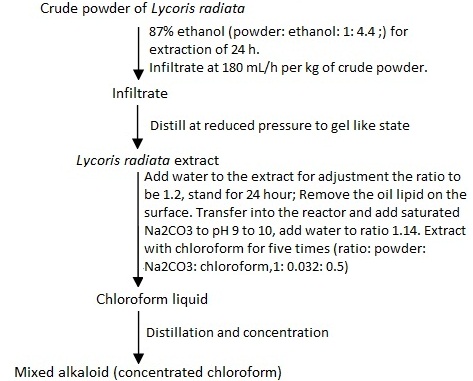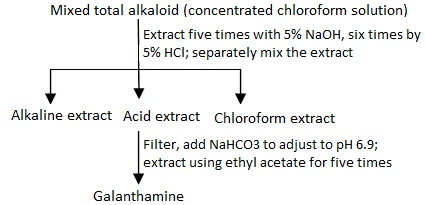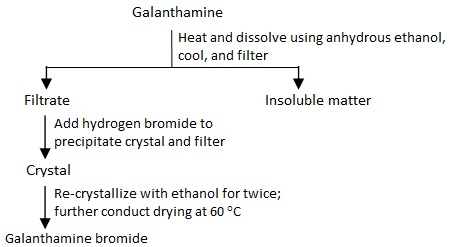| Identification | More | [Name]
Galanthamine hydrobromide | [CAS]
1953-04-4 | [Synonyms]
4A,5,9,10,11,12-HEXAHYDRO-3-METHOXY-11-METHYL-6H-BENZOFURO[3A,3,2-EF][2]BENZAZEPIN-6-OL HYDROBROMIDE
GALANTAMINE HBR
GALANTAMINE HYDROBROMIDE
GALANTHAMIDE HYDROBROMIDE
GALANTHAMINE HBR
GALANTHAMINE HYDROBROMIDE
NIVALIN
NIVALIN, HBR
galanthamine hydrobromide from lycoris sp.
Galanthamine Hydrobromide Injection
GALANTHAMINE HYDROBROMIDUM
(4aS,6R,8aS)-4a,5,9,10,11,12-hexahydro-3-methoxy-11-methyl-6H-Benzofuro[3a,3,2-ef][2]benzazepin-6-ol, Hydrobromide
(-)-Galanthaminium bromide
Hydrobromic acid·galanthamine | [EINECS(EC#)]
217-780-5 | [Molecular Formula]
C17H22BrNO3 | [MDL Number]
MFCD00067672 | [Molecular Weight]
368.27 | [MOL File]
1953-04-4.mol |
| Chemical Properties | Back Directory | [Appearance]
White to Off-White Powder | [Melting point ]
256 °C | [alpha ]
D20 -93.1° (c = 0.1015 in 15 ml H2O) | [refractive index ]
-95 ° (C=1.4, H2O) | [storage temp. ]
−20°C
| [solubility ]
Sparingly soluble in water, very slightly soluble in anhydrous ethanol. It dissolves in dilute solutions of alkali hydroxides. | [form ]
White to off-white crystalline solid. | [color ]
White to Orange to Green | [Water Solubility ]
Soluble in water or DMSO | [Usage]
A selective acetylcholinesterase inhibitor | [Merck ]
4340 | [InChI]
InChI=1/C17H21NO3.BrH/c1-18-8-7-17-6-5-12(19)9-14(17)21-16-13(20-2)4-3-11(10-18)15(16)17;/h3-6,12,14,19H,7-10H2,1-2H3;1H/t12-,14-,17-;/s3 | [InChIKey]
QORVDGQLPPAFRS-ORFATOSYNA-N | [SMILES]
[C@@]123CCN(C)CC4=CC=C(OC)C(O[C@H]1C[C@@H](O)C=C2)=C34.Br |&1:0,14,16,r| | [LogP]
1.750 (est) | [CAS DataBase Reference]
1953-04-4(CAS DataBase Reference) |
| Safety Data | Back Directory | [Hazard Codes ]
T | [Risk Statements ]
R25:Toxic if swallowed. | [Safety Statements ]
S45:In case of accident or if you feel unwell, seek medical advice immediately (show label where possible) .
S36/37/39:Wear suitable protective clothing, gloves and eye/face protection .
S22:Do not breathe dust . | [RIDADR ]
UN 2811 6.1/PG 3
| [WGK Germany ]
3
| [RTECS ]
DF8075000
| [HazardClass ]
6.1 | [PackingGroup ]
II | [HS Code ]
29399990 | [Toxicity]
LD50 i.v. in mice (mg/kg): 5.2 ± 0.2 (Friess) |
| Hazard Information | Back Directory | [Chemical Properties]
White to Off-White Powder | [General Description]
Pharmaceutical secondary standards for application in quality control, provide pharma laboratories and manufacturers with a convenient and cost-effective alternative to the preparation of in-house working standards.
Galantamine Hydrobromide, a reversible, competitive acetyl cholinesterase inhibitor, is suggested for the remedy of mild to moderate dementia of the Alzheimer′s type. | [Biological Activity]
Long-acting, centrally active acetylcholinesterase inhibitor (IC 50 = 410 nM) and allosteric potentiator at neuronal nicotinic ACh receptors. Prevents β -amyloid-induced apoptosis in SH-SY5Y and bovine chromaffin cells. Long-term administration reduces amyloid precursor protein deposition and neurodegeneration in a mouse model of Alzheimer's disease. | [Synthesis]
1. lithium tri-sec-butylborohydride (L-selectride, 1M THF solution, 360.8 mL) was slowly added dropwise to (4aS,8aS)-3-methoxy-11-methyl-9,10,11,12-tetrahydro-4aH-benzo[2,3]benzofuran[4,3-cd]azepin-6(5H)-one (50g. 0.175 mol) in a suspension in THF (1000 mL).
2. The reaction mixture was stirred at -50 to -45 °C for 1 h, followed by continued stirring for 3 h. The progress of the reaction was monitored by HPLC.
3. Upon completion of the reaction, the reaction was quenched by the addition of 40% aqueous hydrogen peroxide (85 g, 1 mol) followed by the addition of aqueous sodium sulfite to decompose the excess peroxide.
4. The reaction mixture was concentrated under pressure and the product was extracted with toluene (1250 mL).
5. The organic phase was concentrated under reduced pressure at 50-55 °C to afford oily (4aS,6R,8aS)-3-methoxy-11-methyl-5,6,9,10,11,12-hexahydro-4aH-benzo[2,3]benzofuro[4,3-cd]azepin-6-ol (galanthamine base).
6. Galanthamine base was dissolved in a solvent mixture of ethanol (200 mL) and deionized water (50 mL), 48% aqueous hydrobromic acid (31.09 g, 0.185 mol) was added, and stirred for 2 hours at 15-20 °C.
7. The product was collected by filtration and dried under vacuum at 50-55 °C to afford (4aS,6R,8aS)-3-methoxy-11-methyl-5,6,9,10,11,12-hexahydro-4aH-benzo[2,3]benzofuro[4,3-cd]azepin-6-ol hydrobromide in the form of a white crystalline powder (55 g, 85.4% yield).
8. The chromatographic purity of the product was 99.85% by HPLC, the enantiomeric purity was 100%, the melting point was 253 °C (decomposition) and the specific optical rotation [α]25D = -96.5 (c 0.1, water).
9. The structure of the product was confirmed by IR, 1H NMR, 13C NMR and HRMS. | [target]
AChR | AChE | [storage]
Store at -20°C | [References]
[1] Organic Process Research and Development, 1999, vol. 3, # 6, p. 425 - 431
[2] Tetrahedron Asymmetry, 2014, vol. 25, # 2, p. 117 - 124
[3] Tetrahedron Letters, 1998, vol. 39, # 15, p. 2087 - 2088 |
| Questions And Answer | Back Directory | [Outline]
Galantamine hydrobromide also called as 11-methyl-3-methoxy-4a, 5, 9, 10, 11, 12-hexahydro-6H-benzene and furan [3a, 3, 2-ef] [2] benzazepine-6-ol hydrobromide, is an alkaloid isolated from Lycoris plants. In the 1960 s, China had first successfully isolated it from domestic Medicago Lycoris and Lycoris radiata, and had recorded into the Chinese Pharmacopoeia in 1977. The hydrobromide salt is white crystalline powder and is odorless with bitter taste. It is soluble in water, slightly soluble in ethanol but insoluble in chloroform, acetone, and ether. The absorption coefficient (50 ug in 1 ml of water): at 289nm wavelength, it has an absorption coefficient of 79.6~86.2. It is mainly applied to myasthenia gravis, poliomyelitis sequelae and resting stage as well as being used for the treatment of children with cerebral paralysis, polyneuritis, radiculitis and sensory motor disorders caused by nerve disorders or trauma. It is clinically also used for the treatment of Alzheimer's disease as well as treatment of dementia and memory disorders caused by the organic disease of the brain with significant therapeutic effect.
Galantamine is a kind of phenanthridine alkaloids discovered by the Soviet scholars 50 years ago. It is the inhibitor of the reversible cholinesterase (ChE) and can selectively inhibit the real cholinesterase (AChE). Galantamine belongs to the second generation of acetylcholinesterase inhibitor drugs with its pharmaceutical composition being same as the extracted alkaloids of the European Mountain narcissus bulb. This kind of herbal medicine has already had a history of 30 years of clinical application in some countries and regions for the treatment of reversal neuromuscular blockade, myasthenia gravis, and children with cerebral palsy psychosis.
| [Cholinesterase inhibitors]
Galantamine Hydrobromide is the hydrobromide salt form of galantamine, a tertiary alkaloid obtained synthetically or naturally from the bulbs and flowers of Narcissus and several other genera of the Amaryllidaceae family with anticholinesterase and neurocognitive-enhancing activities.It can improve the cognitive abilities of Alzheimer's patients and has been already applied as the drug of the treatment of mild to severe Alzheimer's disease (AD) drugs and has entered into market in EC countries. "Chinese Pharmacopoeia" has included the both the raw material and injection of galantamine hydrobromide. It is clinically mainly used for the treatment of poliomyelitis (polio) sequelae, muscular dystrophy and myasthenia gravis. It can be used to substitute neostigmine methyl-sulfate for antagonism of tubocurarine but with weak performance with the usage amount being ten times as high as the usage amount of neostigmine methyl-sulfate. Intravenous injection of 0.5 mg/kg of galantamine hydrobromide can quickly reverse the central anticholinergic effects caused through injection of scopolamine hydrobromide. It can also be used for treating children cerebral palsy, traumatic sensorimotor disorders, multiple neuritis and radiculitis.
The above information is edited by the Chemicalbook of Dai Xiongfeng. | [Physical and Chemical Properties]
It is white crystalline powder and is odorless with bitter taste. It is soluble in water, slightly soluble in ethanol and insoluble in acetone, chloroform, ether and benzene.
| [Extracting Lycoris galantamine hydrobromide]
Galantamine hydrobromide can be extracted from Amaryllidaceae plant Lycoris radiata with the process of extraction, separation and preparation as below:
The first step: the extract of total alkaloids

Step two: The separation of galantamine

Step three: Preparation of galanthamine hydrobromide

| [Pharmacological effects]
Galantamine hydrobromide is a kind of tertiary amino alkaloid and is a reversible competitive inhibitor of cholinesterase. With the deepened understanding of the Alzheimer’s disease (AD) pathogenesis, people have started the study of using this product for treating AD in the early 1980s. In 1987, the United States scholars Bonnie had first successfully receive a patent of applying galantamine hydrobromide for treatment of AD. After this, many countries, one after another, have carried out related pharmacological, pharmacodynamic and pharmacokinetic studies related to it. This result had showed that galantamine hydrobromide, as the second-generation cholinesterase inhibitors, targeted on nerve synapses by competing with acetylcholine for binding to the cholinesterase and further blocking this enzymatic degradation of acetylcholine and therefore increasing the acetyl choline concentration inside the brain.
| [Pharmacokinetics]
In 1989, Miliailova et al reported the pharmacokinetic studies of galantamine hydrobromide on humans. Studies have shown that, subcutaneous injection and oral administration can give similar excellent bioavailability. When being administered with 8-32 mg per day, the pharmacokinetics of this product exhibits a linear correlation. Oral administration of this tablets for 4 mg per time, 2 times per day has the serum half-life (t1/2) being 5-7 h, the average time for reaching peak (Tmax) being 0.5-1 h, and the protein binding rate being 20%. Nearly 50% of the drugs are excreted through urine in which 25% is proto-drug, 20% has been metabolized into O-demethylated galantamine-glucuronic acid, and 5% is the N-demethylated galantamine while those drugs which has been metabolized into galantamine or galantamine ketone only accounting for less than 2%. The ratios of the distribution level of this product in mouse tissue and its plasma levels were: erythrocytes 1.3, brain 2.1, liver 5.0, and the kidney concentration is 10 times as high as plasma concentration.
| [Indications]
It is suitable for treatment of benign memory disorders, improving the directed memory, associative learning, image memory, nonsense figure recognition and also portraits recalling capability of the patients. It can also alleviate the symptom of dementia patients and also memory impairment caused by organic brain lesions.
| [Drug Interactions]
Galantamine hydrobromide can play a potential role on weakening the treatment efficacy of the anti-cholinergic drug.
It has synergistic effect in combination with cholinomimetic effectors and other kinds of cholinesterase inhibitors.
Combined with cimetidine ketoconazole may increase the bioavailability of the product.
Combination with erythromycin can reduce the efficacy of this product.
It has been reported that the combination between galantamine hydrobromide with digoxin can cause atrioventricular block
| [Side effects]
Nervous System: Common symptoms include fatigue, dizziness, headache, trembling, insomnia, dreaminess; and hypertonia, rate aphasia, hyperactivity, etc in some rare cases.
Gastrointestinal system: nausea, vomiting, abdominal distension, abdominal pain and diarrhea, anorexia and weight loss as well as indigestion.
Cardiovascular system: commonly bradycardia, arrhythmia; rarely hypotension.
Blood system: commonly anemia; occasionally thrombocytopenia .
Endocrine and metabolic systems: occasionally increased blood sugar; hypokalemia had also reported.
| [Contraindications]
Patients being allergic to galantamine hydrobromide are prohibited
Galantamine, as a kind of cholinesterase inhibitors is prohibited during the process of anesthesia
Patients with angina and bradycardia are disabled
Patients with severe asthma or pulmonary dysfunction are disabled
Patients of severe liver damage were banned
Patients of severe kidney damage were disabled
Patients with mechanical obstruction are disabled
| [Uses]
It can be used for the treatment of neurological diseases and trauma-induced movement disorders, multiple neuritis, and radiculitis.
Cholinesterase inhibitors can reverse the process of scopolamine-induced amnesia.
|
|
|